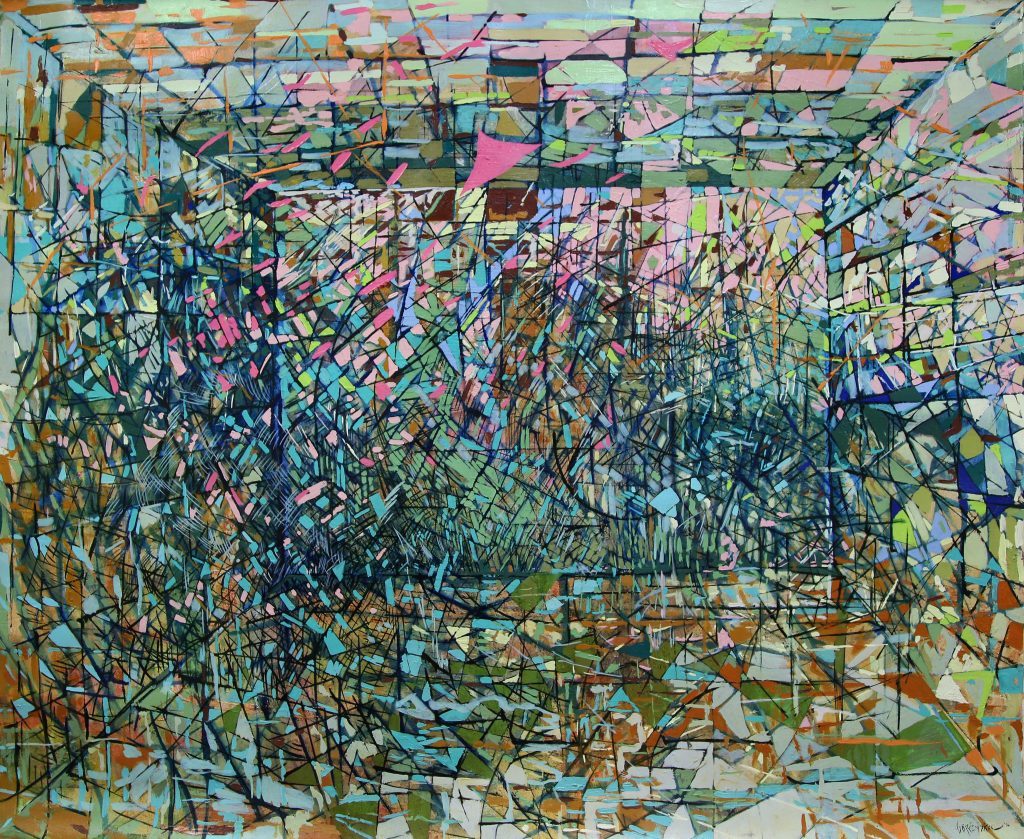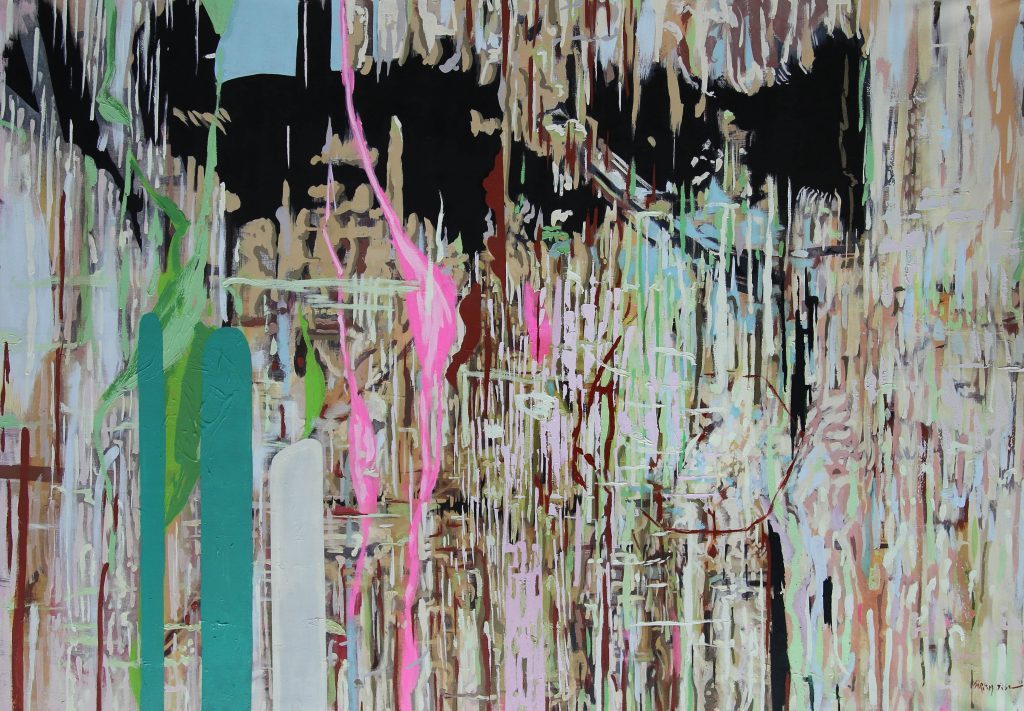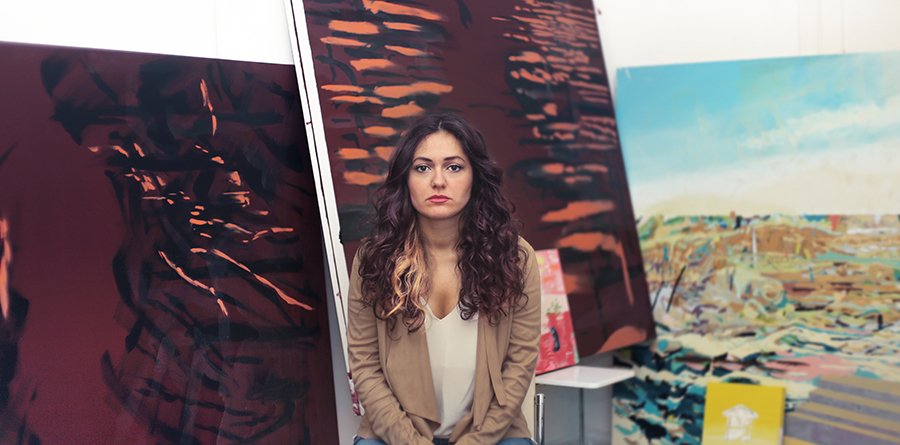Losing oneself in Görkem Dikel’s paintings feels like asking questions never asked before and in the middle of a cosmic riddle; she believes an artist should constantly improve herself and should not be afraid of making mistakes. We talked to Dikel about her artistic journey and her compositions defying perception, pushing us to question our knowledge of the universe.
How did you discover your passion for art? How did you decide to become a professional artist?
I decided to study art at a very early age. Growing up in a family involved in art was influential. I used to make drawings on pieces of paper, encyclopedia and underneath our marble coffee table. I always used to watch my mother paint anyway. My sister, on the other hand, is a photographer. Actually I don’t regard art as a profession; rather it’s part of my personality.
Your works manifest traces of various technical and thematic approaches. Some appear to be closely related with pop art, whereas others have a more abstract expressionist language. In your opinion, how did your art change over time? Do you feel close to a particular artistic movement?
I’ve been through various stages throughout my artistic career. In my early years at school, I was looking for a form of realism based on objectivity; as I began to interprete masterpieces, study drawing and harmony after a short while, I also began to produce more abstract and expressive paintings. Yet my approach continued to remain painterly. After unraveling the secrets of the form to some extent, I tended to deconstruct it. As we do so, we do a rationalist intervention on it, and certain questions enter the sphere of the traditional approach of spatiality. I also began to focus on nature back then. I used to look at Cecily Brown and Joan Mitchell on a daily basis; I still do. Again, in that period I was often influenced by Spaghetti Western cinema and desert atmosphere.
My urge to fragment forms turned into an urge to decompose the matter. Analyzing it in relation to other surrounding forms of matter, I study those transitions between the states of solid, liquid and gas. I explore illusions emerging from those dimensions beyond our perception. And doing all this, I compare the already existing questions on space with questions on spatiality in painting. Some say that the language of my paintings reached maturity relatively early; I owe it to my lack of fear of producing garbage work. I discovered a lot thanks to my spontaneous experimentations.
Regarding movements, I feel close to the 50s’ American Abstract Expressionism, the New Leipzig School, the Young British Artists, the Bay Area Figurative Movement, Early Renaissance, icons and primitive art forms like Cycladic art. Still, I place myself within the realm of the 21st century abstract painting. We are barely leaving the 1st quarter of it behind and some key developments have already taken place. The subject of my thesis, the understanding of abstraction and spatiality in the 21st century, is surely based on the 20th century legacy but it’s also affected by contemporary media. The return of trends from the past, the impact of fragmented, distorted and unpredictable urban areas on our aesthetic perception, pipes, triangles, geometric contours, wild animals, the desert, tropical plants, inter-textural nuances and virtual symbols all entered the realm of painting and they currently reinforce an eclectic understanding of form. The harmony emerging from the combination of disharmonious elements will continue to mark our century as Doctor Frankenstein’s creature.

Your subjects of interest? What are your main sources of inspiration?
I aim at illustrating the interventions of the laws of physics, nature and universe on the lives of individuals. I purposefully named my first solo exhibition “Bigger Than You”. In my paintings, the current state of physics is influenced by tales, memories, dreams and paradoxes, giving way to structures resembling science fiction and thriller. For instance, in my work titled “The Eternal Space of A Mine”, we are looking at a space to which I added a sense of depth through hatchings. Here I make sure that the lines don’t define the room’s shape. Yet a sense of depth going backwards is perceivable; lines floating in the void create claustrophobic cells and solidify the atmosphere. I did this work with the emotions I experienced after the Soma mine disaster. In naming the work I also took into account the fact that, according to Quantum physics, the concept of infinity refers both to the macro and micro levels. Regarding void, the following quote from Victor Vasarely has a lot to tell:
“Many theoreticians studying the notion of the ‘plane’ in painting mix up the two different concepts: the volume and the void. Both are three-dimensional; but while the volume is defined and measurable, the void is the space for a phenomenon to be defined with the passage of time”.
The artists you particularly follow and admire?
I have a huge list of them of whom I will only name a few. Tomur Atagök, İnci Eviner, Selma Gürbüz, Erdoğan Zümrütoğlu, Mahmut Celayir and Mustafa Horasan from Turkey; Qiu Xiaofei, Liu Wei, Isa Genzken, Yutaka Sone, Daniel Heidkamp, Michael Armitage, Jana Schröder, Regina Scully, Jeff Elrod, Eddie Peake, Annie Neukamp, Albert Oehlen and Martin Kippenberger from the world…
You participated to various exhibitions and projects outside Turkey. Which are the most important ones for you?
In 2010, I participated to an international artist residency program in Spain, with students from France, Morocco, Spain and Turkey. As part of the program organized by Fundación Tres Culturas, we realized plastic art activities, panels and presentations at key artistic and cultural sites. Asst. Prof. Erdal Kara from our school joined us as one of the instructors. During our visit to Córdoba we also visited Fundación Antonio Gala, a foundation created by the author and poet Antonio Gala. It was a Mudejar style monastery with a pool at its center. It had an enchanting atmosphere and a gigantic library with amazing books. On my return, I applied to the foundation’s “Jovenes Creadores” artist fellowship with a project I wrote in Spanish and I was selected. On the other hand, in 2013, at my exhibition “Empatía” at Galeria de Arte Aula in Sevilla, I noticed that everyone I knew and didn’t know gave me sincere feedback; art was an object of togetherness and joy. In this sense it was very different from the exhibitions we have here. Here, people have been driven to solitude and isolation; but I think it’s a temporary situation.

What are the greatest challenges for emerging artists in Turkey? What are your recommendations for them?
Young artists face various difficulties ranging from families to gallerists. But as I get to know them better, I realize that they themselves are the biggest difficulty. Artists have to be multi-tasking; they have to be their own designers, managers, translators, social media specialists, carriers and assistants to some degree. Thus they have to be open to development, hardworking and corageous.
How did you come across Art50.net? Your thoughts on online platforms?
I have been selling art through online platforms for the last seven years. My presence in them goes back to my pre-college years. At that time we used to upload our works on portfolio sites, follow each other and exchange comments. Deviantart was one of them; of course I was there with a nickname. There are currently many people in the art scene that I have been following since then.
Online gallery management is a very serious endeavor; it means rendering a cultural product both popular and accessible without compromising meticulousness and high quality. In its present state, Art50.net can easily compete with many international websites in the same field. But all this is not enough either; if you happen to work with a platform that is not good enough, it might cause a lot of burden ranging from logistics to documentation, both for the artist and the collector. Thanks to some personal recommendations Art50.net was a place I already trusted in this regard as well. Then they offered me a collaboration and I was very happy for it. I believe great projects will come out of it.
Click for the artist’s page.

